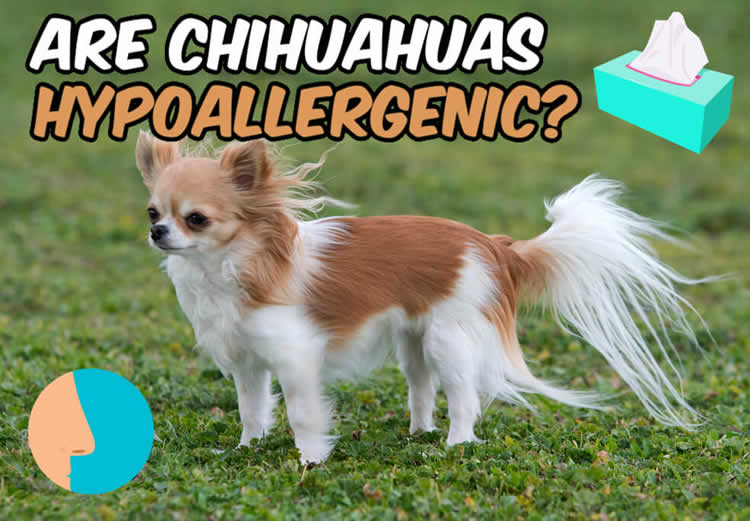
If you suffer from allergies, you might be wondering whether Chihuahuas are hypoallergenic. Pets often trigger allergy attacks in their human counterparts. Statistics show that 10% to 20% of the global population is allergic to dogs and cats. After petting a dog or cat — or even just being around a dog or cat — they’ll experience an allergy attack. The breed’s small size, however, leads many people to believe that Chihuahuas are hypoallergenic.
- What Does Hypoallergenic Mean?
- Are Chihuahuas Hypoallergenic?
- Why Chihuahuas Trigger Allergy Attacks
- What Happens During an Allergy Attack
- Are Smooth-Coat Chihuahuas More Hypoallergenic Than Long-Coat Chihuahuas?
- How to Manage Your Allergies When Living With a Chihuahua
- #1) Install a HEPA Air Purifier
- #2) Change the HVAC Air Filter Monthly
- #3) Get Your Air Ducts Cleaned
- #4) Regulate the Relative Humidity Level
- #5) Dress Your Chihuahua
- #6) Don’t Let Your Chihuahua Sleep With You
- #7) Bathe Twice a Week
- #8) Brush Daily
- #9) Cut Back on the Kisses
- #10) Wash Bedding
- #11) Keep Your Floors Clean
- #12) Keep Your Furniture Clean
- #13) Get Tested
- #14) Allergy Medication
- #15) Immunotherapy
- Can You Develop Allergies to Chihuahuas Later in Life?
- In Conclusion
What Does Hypoallergenic Mean?
To better understand if Chihuahuas are hypoallergenic, you must familiarize yourself with the term. The term “hypoallergenic” is used to describe something that has a low risk of triggering allergy attacks. The prefix “hypo” comes from the Greek language meaning “below normal,” whereas “allergenic” means something that causes allergies.
Some of the first known uses of the term hypoallergenic occurred in the 1950s, during which cosmetic companies used it to market their products to allergy sufferers. Since then, hypoallergenic has been used to describe everything from fabrics, laundry detergents, food and dog breeds.
Are Chihuahuas Hypoallergenic?
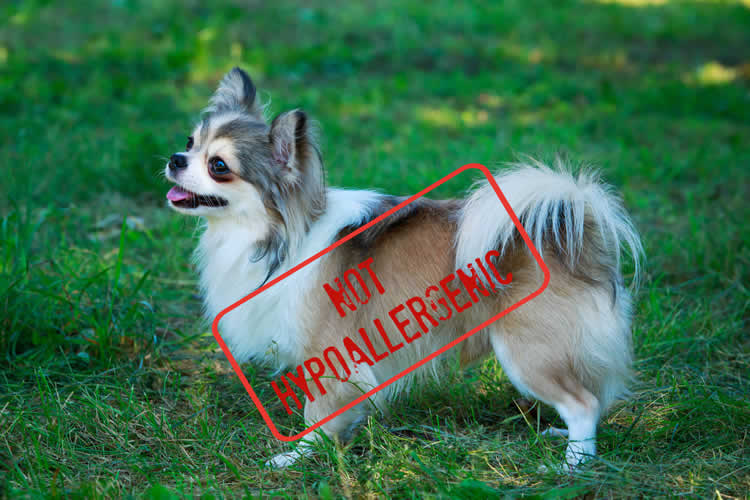
Contrary to common belief, Chihuahuas are not hypoallergenic. There’s no evidence indicating that Chihuahuas are any less likely to trigger allergy attacks than other breeds. Furthermore, the Chihuahua typically isn’t touted as a hypoallergenic breed.
Breeds touted as hypoallergenic include:
- Bichon Frise
- Chinese Crested
- Havanese
- Maltese
- Portuguese Water Dog
- Poodle
- Schnauzer (Giant, Miniature, Standard)
- Shih Tzu
- Soft-Coated Wheaten Terrier
- Yorkshire Terrier
Whether or not any breed is hypoallergenic is open to debate. Some owners have reported experiencing fewer allergy attacks with certain breeds but anecdotal accounts such as these aren’t reliable. Allergies can vary from person to person. Just because one person experiences fewer allergy attacks with a particular breed, others may experience the same or more allergy attacks with that breed.
According to a study published in the Journal of Allergy and Clinical Immunology, there is no difference in the airborne levels of a particular allergen known as canis familiaris allergen 1 (Can f 1) between breeds. Breeds touted as hypoallergenic have the same airborne levels of Can f 1 as non-hypoallergenic breeds. Researchers even found that hypoallergenic breeds had higher levels of Can f 1 within their coats. These findings suggest that the term “hypoallergenic breed” is a misnomer.
Why Chihuahuas Trigger Allergy Attacks
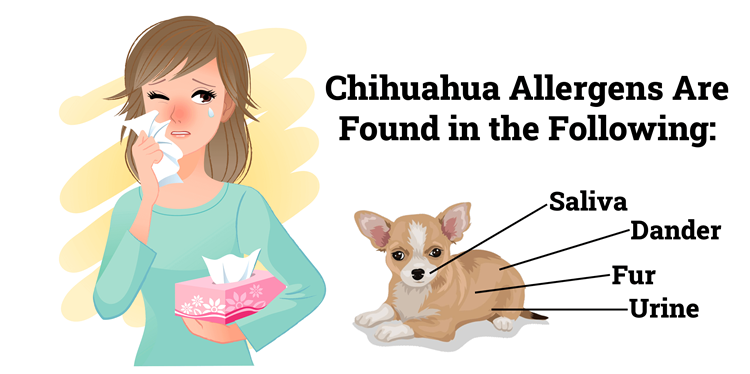
All allergy attacks involve an overactive immune system response to an otherwise harmless substance. These allergy-triggering substances are known as allergens.
People who suffer from food allergies may be allergic to peanuts or eggs. People who suffer from seasonal allergies may be allergic to tree or grass pollen. People who suffer from pet allergies may be allergic to certain proteins produced by dogs and cats.
There are proteins in the saliva, dander (skin cells), fur and urine of all dogs, including Chihuahuas. Some of these proteins are allergens that trigger allergy attacks.
The primary protein-based allergen is Can f 1. A type of salivary lipocalin protein, it affects roughly 50% to 75% of all people who suffer from pet allergies. Other types of protein-based allergens include canis familiaris allergen 2 (Can f 2) through canis familiaris allergen 7 (Can f 7). Chihuahuas and other dogs trigger allergy attacks because some people are allergic to these proteins.
Chihuahuas are small, so they don’t produce or shed as much fur as larger breeds. They also don’t drool as much as many other breeds. If you own a Chihuahua, though, you’ll inevitably be exposed to proteins like Can f 1.
What Happens During an Allergy Attack
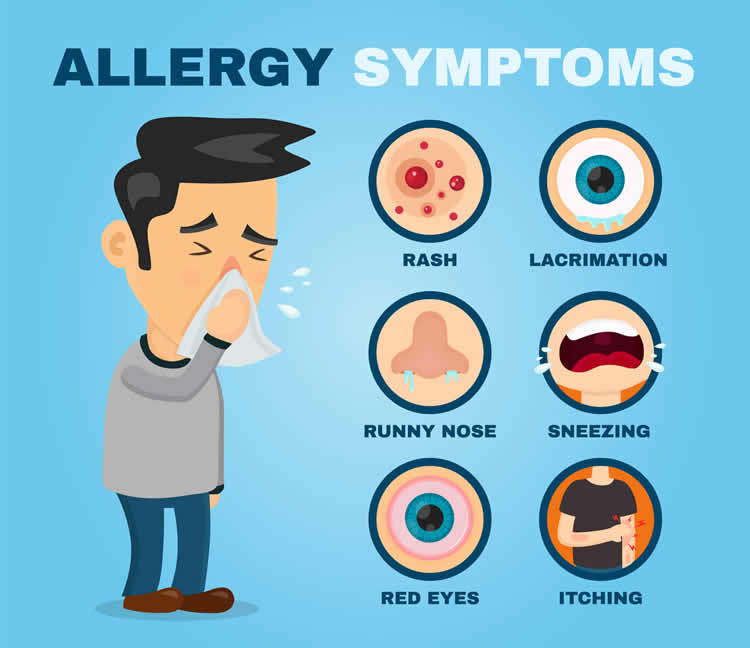 Allergy attacks are characterized by an overactive immune system response. Allergens are typically harmless, but they are wrongfully perceived as foreign invaders by the immune systems of allergy sufferers. The immune system overreacts by attacking the allergens.
Allergy attacks are characterized by an overactive immune system response. Allergens are typically harmless, but they are wrongfully perceived as foreign invaders by the immune systems of allergy sufferers. The immune system overreacts by attacking the allergens.
If you are allergic to Can f 1, your body’s immune system will view this protein as a foreign invader. Exposure to this protein will result in an allergy attack. If you come into contact with your Chihuahua’s saliva, dander, fur or urine, you may experience an allergy attack. Your body’s immune system will then begin an assault using histamines and other chemicals to try and neutralize the Can f 1, which will manifest in the form of an allergy attack.
Symptoms of an allergy attack include:
- Nasal congestion
- Runny nose
- Sneezing
- Itchy, watery eyes
- Inflammation of nasal passages
- Shortness of breath
- Chest tightness
- Rash or hives (for contact allergies)
Are Smooth-Coat Chihuahuas More Hypoallergenic Than Long-Coat Chihuahuas?

Some people assume that smooth-coat Chihuahuas are more hypoallergenic than long-coat Chihuahuas. There are two varieties of Chihuahuas recognized by the American Kennel Club (AKC) and many other canine organizations throughout the world: smooth coat and long coat. Smooth-coat Chihuahuas have a short coat of fur, whereas long-coat Chihuahuas have a long coat of fur.
Conventional wisdom may lead you to believe that smooth-coat Chihuahuas are more hypoallergenic than long-coat Chihuahuas because they shed less. After all, Can f 1 and other protein-based allergens are found in the fur. In theory, less shedding should translate into fewer allergens in the home.
Smooth-coat Chihuahuas have shorter coats, but that doesn’t mean they shed less than long-coat Chihuahuas. Some smooth-coat Chihuahuas have a top coat and an undercoat, in which case they may shed equally if not more than their long-coat counterparts. Those with only a top coat, conversely, may shed less.
Regardless of coat, all Chihuahuas produce dander. Consisting of microscopic-sized flakes of dead skin, dander is the leading vehicle for Can f 1 transmission. Chihuahuas spread Can f 1 through their dander. Smooth-coat and long-coat Chihuahuas produce similar amounts of dander. They’ll leave behind these flakes of dead skin while creating an allergen-ridden living environment for their owners.
How to Manage Your Allergies When Living With a Chihuahua
Chihuahuas may not be hypoallergenic, but there are steps you can take to manage your allergies while living with your furry four-legged companion.
#1) Install a HEPA Air Purifier
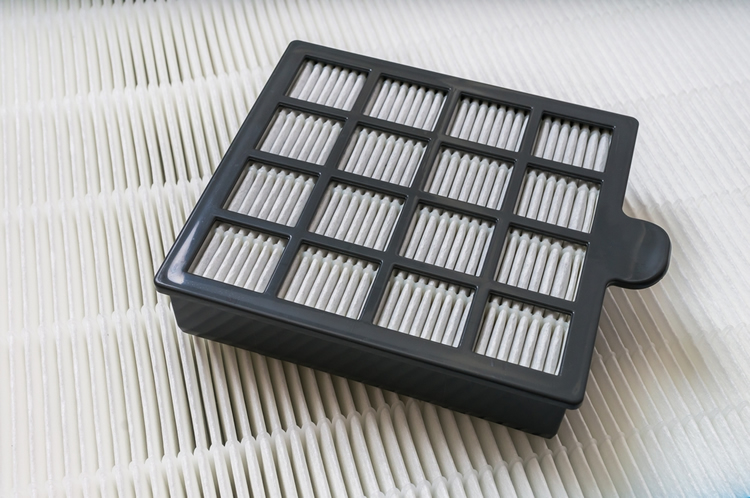
If you’re allergic to your Chihuahua, you may want to invest in a high-efficiency particulate air (HEPA) filter air purifier. Also known as HEPA air cleaners, HEPA air purifiers are devices that clean indoor air via a HEPA filter. Air will enter the HEPA air purifier through an intake, at which point it will pass through the HEPA filter. A fan will then blow the newly cleaned air back into the surrounding space.
HEPA filters are able to trap very small particles of airborne pollutants, such as protein-based allergens. In the United States, only air filters that can remove at least 99.7% of all particulate matter measuring 0.3 microns or smaller in diameter can be marketed as HEPA; it’s a requirement set by the U.S. Department of Energy (DOE). To put that number into perspective, one whole micron is about 1/25,000 of an inch.
HEPA filters, unfortunately, aren’t interchangeable with most heating, ventilation and cooling (HVAC) system air filters. They will restrict the airflow into your HVAC system’s ductwork, resulting in poor heating and cooling performance and equally poor energy efficiency. To take advantage of the allergen-capturing power of a HEPA filter, you’ll need to invest in a portable HEPA air purifier.
#2) Change the HVAC Air Filter Monthly
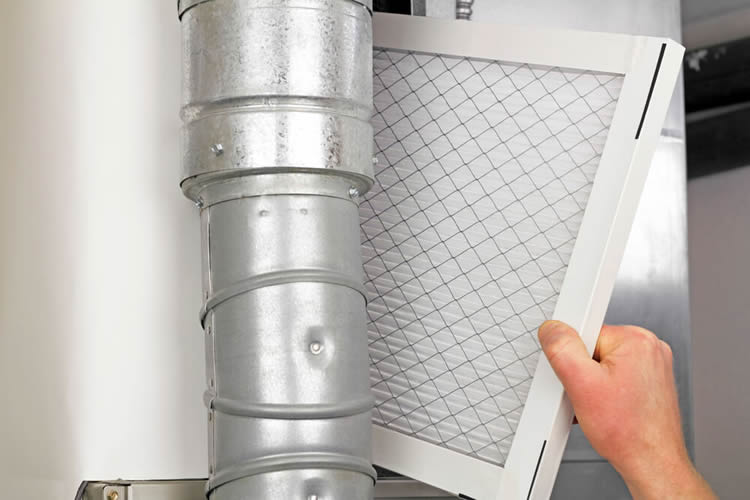
A HEPA filter isn’t a substitution for an HVAC air filter; you’ll still need an HVAC air filter in your air handler or furnace to remove airborne pollutants. When your HVAC system’s fan is running, it will remove pollutants from the air. The fan will pull air through the HVAC air filter, and after passing over the furnace or air conditioning evaporator coil, the newly cleaned air will enter the ductwork.
To control allergens in your home, change the HVAC air filter every month. Allergens will gradually accumulate on the HVAC air filter. The longer it goes unchanged, the greater the concentration of these allergens. Changing it once a month will allow you to dispose of these allergens so that they don’t make their way back into your home.
#3) Get Your Air Ducts Cleaned
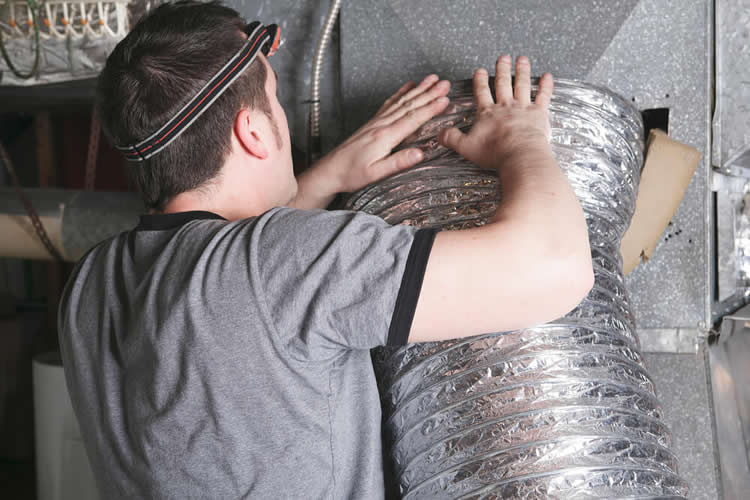
When was the last time your air ducts were cleaned? According to the National Air Duct Cleaners Association (NADCA), most homeowners should get their air ducts cleaned every three to five years. Regular air duct cleanings will promote a more efficient HVAC system while potentially alleviating your pet allergies.
Air ducts are conduits used in HVAC systems. Heated or cooled air will enter the air ducts, at which point the conditioned air will be distributed throughout your home via the supply vents. Over time, airborne particulate matter like dander will accumulate inside these hollow passages. If you don’t get your air ducts cleaned, some of this particulate matter will make its way back out of the air ducts and into your home’s living space.
#4) Regulate the Relative Humidity Level
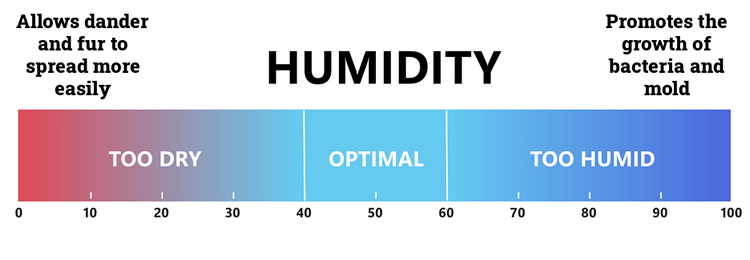
Regulating the relative humidity level in your home can reduce the frequency and severity of your allergy attacks. Humidity is airborne moisture vapor. Your home may seem dry, but there’s probably moisture vapor floating around in it.
Your home’s relative humidity level represents how much moisture vapor is in the air — expressed as a percentage — relative to how much moisture vapor the air can hold at the given temperature. If you suffer from pet allergies, you should strive for a relative humidity level of 40% to 60%. A relative humidity level of 50% means the air is holding half as much moisture vapor as the total amount it can hold at the current temperature.
Allergens spread more easily in homes with a low relative humidity level. A low relative humidity level indicates the air is dry, so dander and fur will float around unrestricted. If the relative humidity level is too high, conversely, it will encourage the growth of bacteria and mold.
To raise your home’s relative humidity level, use a humidifier. Humidifiers are devices that release a mist of water into the surrounding air. To lower your home’s relative humidity level, use a dehumidifier. Dehumidifiers are devices that extract moisture from the air. Alternatively, running your central air conditioning (AC) system will lower your home’s relative humidity level.
#5) Dress Your Chihuahua

It may sound silly, but dressing your Chihuahua can have a positive impact on your allergies. Protein-based allergens spread primarily through dander, which may hitch a ride on your Chihuahua’s fur. Dressing him will contain this dander and fur so that your home stays a little cleaner.
For maximum protection against allergy attacks, choose clothes that cover most of your Chihuahua’s body. A small vest or open-front shirt will leave your Chihuahua’s body exposed, thus allowing dander and fur to escape. A full-size shirt or sweater, however, will cover your Chihuahua’s body and trap these allergen vehicles.
#6) Don’t Let Your Chihuahua Sleep With You
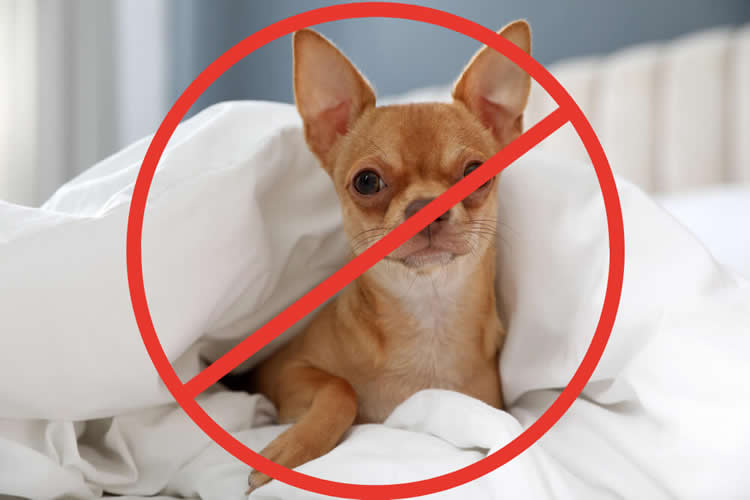
If your Chihuahua sleeps in your bed at night, you should kick him out. Chihuahuas are affectionate, and many of them prefer to burrow in their owner’s bed rather than sleep in their own bed. Chihuahuas, however, will leave allergens wherever they go.
Allowing your Chihuahua to sleep in your bed will result in more allergens on your bed sheets. When lying down at night, you may inhale these allergens. You’ll sleep more soundly at night by coaxing your Chihuahua to sleep in his own bed, preferably outside of your bedroom.
#7) Bathe Twice a Week
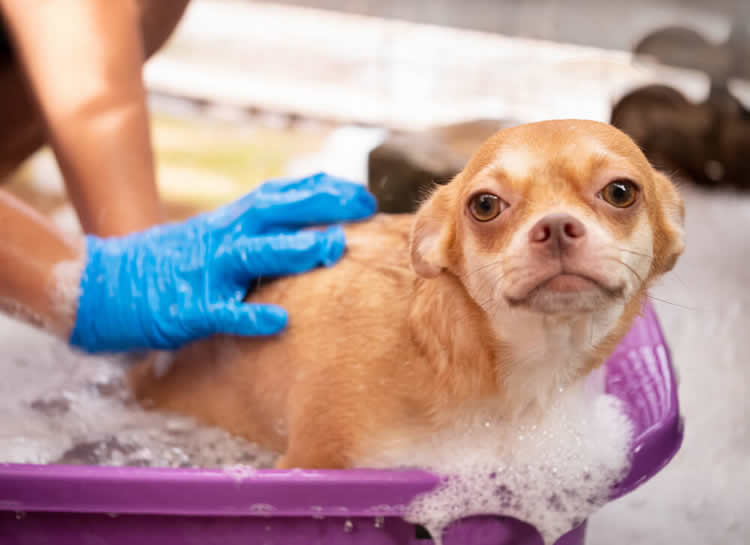
Bathing your Chihuahua regularly will offer some degree of allergy relief. Allergy-triggering proteins are found in your Chihuahua’s dander and fur. When you bathe your Chihuahua, you’ll wash away these allergens so that they don’t accumulate inside your home.
How often should you bathe your Chihuahua exactly? One study found that washing dogs at least twice a week resulted in 84% lower Can f 1 levels in fur clippings and 86% lower Can f 1 levels in dander samples.
Just remember to choose a gentle formula shampoo that’s designed specifically for dogs. Shampoos with harsh dyes, fragrances or other chemicals may dry out your Chihuahua’s skin. If your Chihuahua has particularly dry skin, ask your veterinarian for advice. He or she may recommend a medicated shampoo with moisturizing agents.
#8) Brush Daily
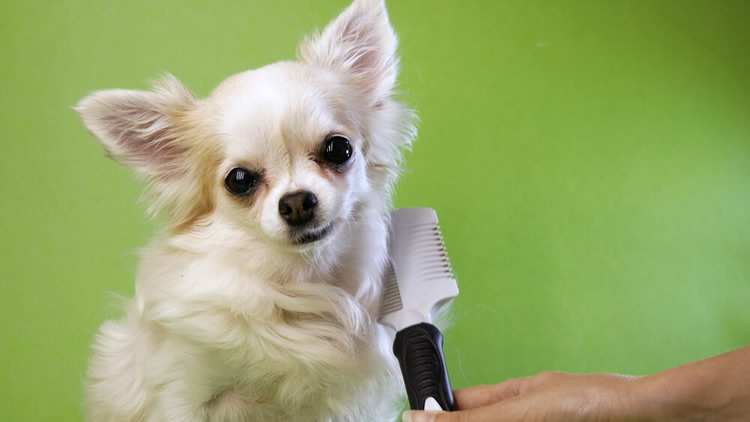
Brushing your Chihuahua at least once a day can improve your allergies. Some of the dander and fur that your Chihuahua sheds will stick to his body. Using a grooming brush, you can remove this loose dander and fur from his coat.
Always wash your hands after brushing your Chihuahua. You’ll probably get some of his dander and fur on your hands during this grooming activity. If you don’t wash your hands, you’ll spread these allergen-carrying vehicles to anything you touch, including your face.
#9) Cut Back on the Kisses
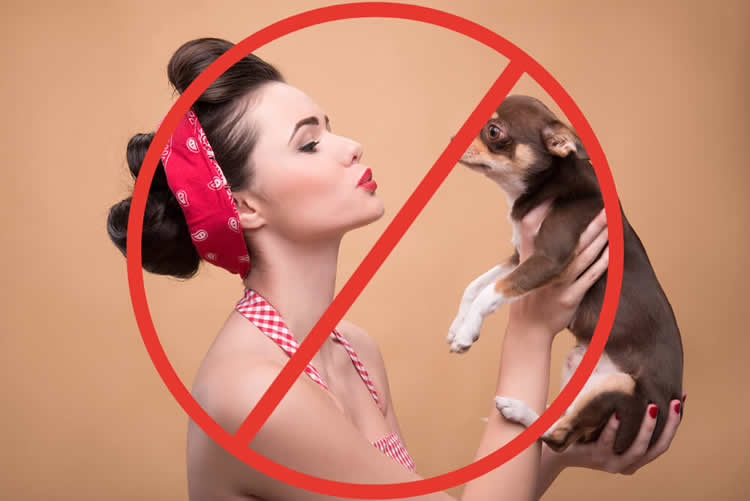
You should refrain from kissing your Chihuahua if you are allergic to him. Kissing will expose you to allergens in his saliva. You’ll get these allergens on your face, which can lead to an allergy attack.
Can f 1 is a salivary lipocalin protein that’s produced by the tongue. When Chihuahuas lick themselves, they transfer some of this protein to their skin and fur. The same thing happens with kisses. Kissing your Chihuahua will transfer Can f 1 and other protein-based allergens from him to you.
There are other ways to show affection to your Chihuahua that don’t involve kissing. You can pet him while speaking softly, or you can play fetch with him. Giving your Chihuahua a treat is another way to show affection.
#10) Wash Bedding Weekly

Washing your Chihuahua’s bedding at least once a week can make a positive difference in your allergies. Bedding consists of pet beds, blankets, sheets and pillows that your Chihuahua uses to sleep and rest. It’s a key source of allergens.
When sleeping, your Chihuahua will shed dander and fur, which contain allergens. The longer your Chihuahua’s bedding goes unwashed, the more allergens it will contain. Washing his bedding in hot water — along with a small amount of pet-safe laundry detergent — will rinse away the dander and fur.
#11) Keep Your Floors Clean
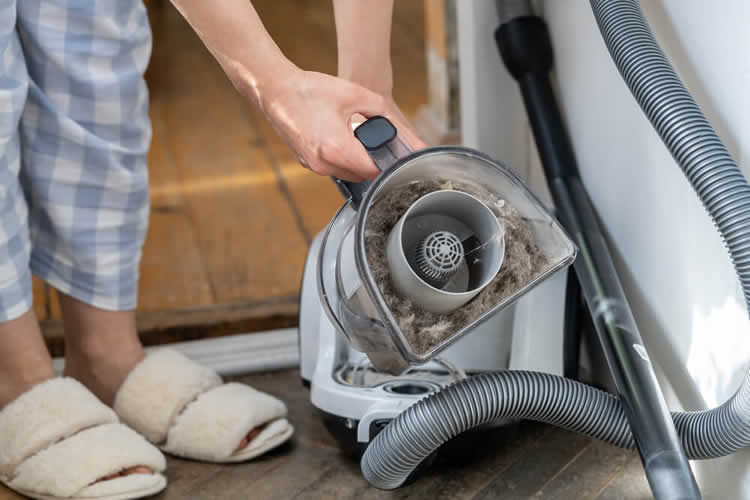
Maintaining clean floors is essential to keeping your allergies in check. After being kicked up into the air, allergens will gradually fall and settle on the floor. But they will likely be kicked back into the air when you walk by them or when the fan turns on.
For carpeted floors and rugs, use a high-suction vacuum cleaner with a beater bar. Beater bars are rotating brushes on the bottom of a vacuum cleaner. When pushing a vacuum cleaner over carpeted floors and rugs, the beater bar will fluff up the fibers. The suction mechanism will then suck up dander and fur.
For hardware, laminate, vinyl and other hard floor types, you can either use the same type of vacuum cleaner but with the beater bar disabled, or you can use a special type of vacuum cleaner that’s designed for hard surfaces. You can also go back over these hard surfaces with a damp mop to remove any lingering allergens. Try to get into the habit of vacuuming your floors at least twice a week to minimize allergen buildup.
#12) Keep Your Furniture Clean

Dander and fur will find their way onto your furniture. You can always prohibit your Chihuahua from jumping onto your furniture, but that’s not always enough to prevent allergen buildup. As your Chihuahua walks around on the floor, he will release dander. Once in the air, dander will float to nearby surfaces, such as couches and recliners.
You can clean upholstered furniture using a vacuum cleaner brush attachment. Brush attachments feature softer bristles than those of beater bars, allowing them to remove dander and fur without damaging your furniture.
Another way to clean upholstered furniture is to use a lint roller. It’s a faster and more convenient cleaning method that doesn’t require pulling out the vacuum cleaner. Lint rollers are handheld tools with a barrel-shaped roller element. The roller element supports a roll of special tape. As you roll it over your furniture, the tape will pick up loose dander and fur.
#13) Get Tested

If you haven’t done so already, you should consider getting an allergy test. It will reveal the specific allergens to which you are allergic. You may think you are only allergic to pet dander when you are actually allergic to mold, pollen and dust mites as well. Most people who suffer from pet allergies, in fact, are allergic to multiple substances. With an allergy test, you’ll know which substances to avoid.
There are two primary types of allergy tests: blood and skin. They both involve measuring specific types of immunoglobulin E (IgE) antibodies. When you are exposed to a particular allergen, your immune system will produce IgE antibodies for that allergen. Blood allergy tests simply measure IgE antibodies in the blood, whereas skin allergy tests measure IgE antibodies on the skin.
#14) Allergy Medication

If you’ve tried all of the aforementioned methods and still experience frequent or severe allergy attacks, talk to your doctor about allergy medication. Antihistamines are highly effective at treating allergies. They are a class of drugs that, as the name suggests, suppress the effects of histamines.
Histamines are naturally occurring chemicals that our bodies use to fight infections. When exposed to an allergen, your immune system will attack the foreign substance with these chemicals. Antihistamines work by binding to histamine receptors in the brain. Your immune system may still release histamines, but these chemicals won’t be able to attach themselves to your histamine receptors. Therefore, your symptoms may clear up. The downside is that most people experience drowsiness as a side effect.
There are two primary generations of antihistamines. They are both available over the counter and without a prescription. Unlike first-generation antihistamines, second-generation antihistamines don’t fully cross the blood-brain barrier. They are just as effective at treating allergies as first-generation antihistamines, but second-generation antihistamines don’t cause drowsiness for this reason.
First-generation antihistamines include:
- Diphenhydramine (Benedryl)
- Brompheniramine (Dimetane)
- Chlorpheniramine (Chlor-Trimeton)
Second-generation antihistamines include:
- Loratadine (Claritin)
- Fexofenadine (Allegra)
- Desloratadine (Clarinex)
- Rupatadine (Rupafin)
#15) Immunotherapy

Depending on the severity of your allergies, you may want to consider immunotherapy. Also known as biological therapy or simply “allergy shots,” it’s designed to desensitize the immune system to the problematic allergen or allergens.
Allergies involve a hypersensitivity to an otherwise harmless substance. During immunotherapy, your doctor will intentionally expose you to small amounts of the allergen. Your doctor will give you shots, with each of these injections containing an allergen sample. It shouldn’t be enough to trigger a full-blown allergy attack, but your immune system will still identify the allergen.
With immunotherapy, your immune system will build up a tolerance to the allergen. It’s typically effective, but it can take years to work. Most immunotherapy programs last about two or three years.
Can You Develop Allergies to Chihuahuas Later in Life?
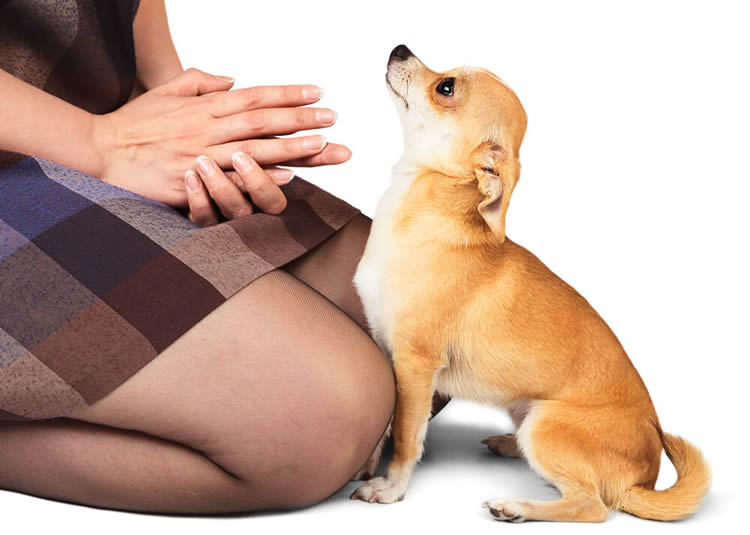
You can absolutely develop allergies to Chihuahuas later in life. No one is actually born with allergies. Whether pet allergies, food allergies, seasonal allergies, etc., people develop allergies after birth.
Some people become allergic to dogs and cats at an early age. It may take months or years of exposure to develop allergies. With that said, pet allergies are rare in infants. Most children don’t begin to exhibit symptoms of pet allergies until they are over the age of 1.
Even if you’re well into adulthood, you can still develop allergies to Chihuahuas and other pets. Your immune system will change as you grow older. It may begin to underreact or overreact to certain substances. These changes can manifest in the form of pet allergies.
In Conclusion
They are amazing companions that provide unconditional love and loyalty, but Chihuahuas are a source of distress for many owners. Since they aren’t hypoallergenic, they can trigger just as many allergy attacks as other breeds. The good news is that you can manage your allergies by following the tips outlined above.
References:
Does your Chihuahua give you allergies? Let us know how you cope with allergy attacks in the comments section below!